2016 Aprilia Tuono V4 1100 Factory Review

A love affair on two wheels
It’s no secret we here at MO are huge fans of the Aprilia Tuono. We’ve declared our love for the bike so much now that we’re starting to sound like a broken record. And if you’re tired of us blabbering on and on about one of Italy’s finest motorcycles, there’s bad news: Aprilia has gone and made the Tuono even better with the Tuono V4 1100 series, the $14,799 RR and the $16,999 Factory. Head Honcho Kevin Duke got to spend time aboard the RR version at the bike’s launch, which you can read about here. The up-spec Factory version, with Öhlins suspension and steering damper, aluminum (rather than the RR’s steel) front brake rotor flanges, a wider 200/55-17 rear tire and red wheels, wasn’t available for Duke to ride, but we have one now. So how does it stack up? First a little back story.
2016 Aprilia Tuono V4 1100
| Engine | 19.0/20 |
| Suspension/Handling | 14.0/15 |
| Transmission/Clutch | 9.0/10 |
| Brakes | 9.0/10 |
| Instruments/Controls | 3.5/5 |
| Ergonomics/Comfort | 8.5/10 |
| Appearance/Quality | 8.5/10 |
| Desirability | 9.5/10 |
| Value | 9.0/10 |
| Overall Score | 90/100 |
We last judged the Tuono V4 APRC against its peers in 2014, putting it up against the BMW S1000R and the almighty KTM 1290 Super Duke R in our 2014 Ultimate Streetfighter Finale. Despite its superb handling, and lowest price of the trio, there was one little issue: its 999cc V-Four made less power and less torque than its German and Austrian competition and seemed a tad less refined. Yeah, it’s a matter of picking nits, but when the stakes are this high and this close, every little edge counts. In the end, the Tuono brought up the rear of that admittedly remarkable pack.
To quote the one and only Ricky Bobby, “if you ain’t first, you’re last.” Now, I don’t know if the folks at Aprilia took any inspiration from Talladega Nights, but the message was received all the same – the Tuono needed more muscle. Unlike the RSV4, which is restrained by engine displacement regulations under racing rulebooks worldwide, the Tuono is under no such restrictions, and so Aprilia’s answer was simple: Make the engine bigger!
The result is this, the Tuono V4 1100. As the name suggests, the new Tuono (Aprilia calls it an early-release 2016 model) gets a displacement bump, but not quite to 1100cc. Instead, a 3mm overbore puts it at 1077cc. Aprilia claims 89.2 lb-ft of torque at 9000 rpm, 175 hp, and nearly 20 more horses at 8000 rpm compared to the outgoing model (all measurements made at the crankshaft).
We’re accustomed to manufacturer claims being a bit optimistic compared to actual dyno numbers, but here’s a bit of a surprise: Our Tuono V4 1100 Factory, on the MotoGPWerks dyno, put down numbers to the rear wheel that are almost in line with Aprilia’s claims – 82.8 lb-ft at 9400 rpm and 159.3 hp at 11,400 rpm. Factor in 10% driveline loss and these numbers are actually better than what Aprilia claim at the crank. True to its word, Aprilia also made the Tuono 1100 20 horses beefier around the 8000 rpm mark. With this bump in power, the Aprilia now trumps the S1000R and Super Duke R in the power department, though the 1301cc KTM still has it beat on torque.
Despite this power increase, the Tuono is still held back on the scales, coming in at 467 lbs. ready-to-ride. That’s 7 lbs. less than before, and now 2 lbs. less than the KTM. The S1000R is still the lightest of the three at 450 lbs. on our scales.
Aprilia didn’t just stop at bumping the V4’s displacement and power, it also tweaked the chassis. Headstock angle goes to 24.7º from 25.1º, trail is lessened to 99.7mm from 107.4mm, and to help keep the chassis stable, the swingarm is now 6mm longer. On the electronics front, the Tuono 1100 range also gets the same aPRC electronics suite as the RSV4 RR and RSV4 RF, which includes Aprilia Traction Control, Wheelie Control, Launch Control and Quick Shift functions, the first two receiving even more refinement than its predecessor.
To get the full scoop on the details of the Tuono V4 1100 series, go to Duke’s First Ride story above. This review centers on the Tuono V4 1100 Factory, as KD didn’t get a chance to ride it during the bike’s launch.
Same Old Charm
As it’s always been with the V4 Tuonos, the center of attention is the 65º V-Four between the rider’s legs. It can be relatively docile below 6000 rpm even if fuel delivery is a bit rough at partial throttle. However, once you wake up the beast and push the tach needle above the 6k mark, the dramatic increase in power compared to the 999cc mill is instantly noticeable. Asses are pushed back in the seat, necks are tightened, and arms are flexed, all in an effort to simply stay on the bike. It’s exhilarating when you’re blasting onto the freeway, and it’s downright thrilling when you’re annihilating your favorite twisty road, eating straight patches between corners like few bikes can. The front likes to lightly paw at the air if you get greedy coming out of a corner, and the Wheelie Control helps make the rider feel like a hero as it gently places the tire back on the road again.
“Using Wheelie Control is ideal for blazing a fast pace down a twisty road, as it allows the front tire to loft without fear of flipping over backward,” Duke observes. “However, switching it off and carrying a long wheelie for giggles is difficult, as maintaining carefully balanced throttle inputs can be problematic.’
Aprilia revised the ride modes for the new Tuono series, tossing the old Rain setting and replacing with Sport, Track and Race modes, all of which deliver full power output and can be switched on the fly. Sport mode gives the Tuono a slightly more subdued demeanor. Track and Race modes have less engine braking than Sport but were otherwise difficult to distinguish between.
Aprilia says the Tuono’s handlebars are now a little lower and narrower by 6mm, but like Duke in his First Ride review, I couldn’t tell a difference between old and new. The Tuono, with its emphasis on mass centralization, changes direction quickly and smoothly, the front end feeling sure-footed and planted. It goes without saying the fully adjustable Öhlins fork, shock and steering damper helped contribute to that sure-footed feeling.
One aspect that confuses us about the Tuono V4 1100 Factory is the lack of forged wheels. Öhlins suspension and lightweight forged aluminum wheels are what we’ve come to expect from the added price of Factory models, and the omission of the latter here is puzzling.
“The one gripe I have about the Tuono is its somewhat lardy weight,” Duke whinges. “If I’m gonna spend $2,200 extra for the Factory version, I’d expect the lighter forged wheels, which we know reduces steering effort considerably over heavier cast wheels.”
And while we’re on the topic of demerit points, it’s hard to believe the Tuono makes due with its seemingly archaic LCD gauge cluster. Sure it does the job and provides all the relevant information, but it looked dated even when new, and now that colorful TFT displays are becoming more prevalent, it’s probably time Aprilia make the gauges more, well, engaging.
Brembo M432 monobloc radial calipers bite on twin 320mm discs to bring the Tuono to a halt, and while there are no complaints about the braking ability on the Tuono, once you’ve been spoiled by Brembo’s M50 calipers, everything else feels second rate. The Tuono comes with a Race ABS system, developed in collaboration with Bosch, featuring three different levels, all adjustable independent of engine power mode, and featuring rear-wheel-lift mitigation to help prevent a rider from looping the bike in a panic situation. RLM can also be turned off.
During our street evaluation of the Factory we never encountered a situation that would be anywhere near approaching the ABS threshold. However in past tests of the system, particularly in a track environment, we’ve been impressed with how hard and deep one can brake into a corner without so much as a hint of ABS intervention.
Finer Details
With this new Tuono V4 1100 Factory, Aprilia has answered the call for more power without losing any of the endearing qualities we’ve always loved about the Tuono. The ride position is clearly more relaxed than the RSV4, the handlebar still placed in a sporty position, but comfortable enough for a moderate slog down the freeway. The bike’s new seat is a nice improvement over the old one, slightly cushier despite having been lowered 15mm to make for an easier reach to the ground. It’s still tall at 32.5 inches, but it does provide a commanding view of the road ahead.
While it’s unlikely prospective Tuono owners will fret much about fuel economy, our Factory tester reinforced the reputation Aprilia V-Fours have for voraciously consuming fuel. It returned a dismal 31 mpg from its 4.9-gallon tank in mixed riding conditions. But, considering the huge grin it puts on our faces each time we twist the throttle or throw it into a bend, we’d be happy to pay that price time and time again.
Now that Aprilia has taken the Tuono V4 1100 Factory to the gym and bulked it up, it’s clearly a time for a rematch amongst its rivals. Which is exactly what we’re putting together. Stay tuned.
2015 Aprilia Tuono V4 1100
+ Highs
- A fantastic engine made even better
- The handling chops to match the sweet engine
- Sophisticated electronics
– Sighs
- No forged wheels on a Factory?!
- That engine is thirsty
- Still a tad on the heavy side
2016 Aprilia Tuono V4 1100 Factory Specifications | |
|---|---|
| Engine Type | 65° V-4, 4-stroke, liquid cooled engine with dual overhead cams and four valves per cylinder |
| Bore and stroke | 81.0 x 52.3 mm |
| Capacity | 1077 cc |
| Horsepower (at rear wheel) | 159.3 hp at 11,400 rpm |
| Torque (at rear wheel) | 82.8 lb-ft at 9400 rpm |
| Fuel system | Airbox with front dynamic air intakes. 4 Weber-Marelli 48-mm throttle bodies with 4 injectors and latest generation Ride-by-Wire engine management. Choice of three different engine maps selectable by the rider with bike in motion: T (Track), S (Sport), R (Road) |
| Exhaust | 4 into 2 into 1 layout, single oxygen sensor, lateral single silencer with ECU-controlled bypass valve and integrated trivalent catalytic converter |
| Alternator | Flywheel mounted 450 W alternator with rare earth magnets |
| Lubrication | Wet sump lubrication system with oil radiator and two oil pumps (lubrication and cooling) Gearbox 6-speed cassette type gearbox |
| Clutch | Multi-plate wet clutch |
| Final Drive | Chain: 42/16 |
| Front Suspension | Öhlins fork with TIN surface treatment. Adjustable spring preload and hydraulic compression and rebound damping; 120mm travel |
| Rear Suspension | Double braced aluminum swingarm; Öhlins Racing monoshock with piggy-back, fully adjustable in: spring preload, wheelbase length, hydraulics in compression and rebound; 130mm of travel |
| Front Brakes | Dual 320mm floating stainless steel discs with aluminum flanges, Brembo M432 monobloc radial calipers with four 32mm opposing pistons. Sintered pads. Axial pump master cylinder and metal braided brake hoses. |
| Rear brake | 220mm disc; Brembo floating caliper with two 32mm pistons. Sintered pads. Master cylinder with built in reservoir and metal braided hose. Bosch 9MP ABS, adjustable to 3 maps equipped with RLM (can be disabled). |
| Wheels and Tires | Cast aluminum; Front: 3.5”x17” Rear: 6.00”x17” Radial tires. Front: 120/70ZR-17 Rear: 200/55ZR-17 |
| Saddle height | 32.5 inches |
| Steering angle | 24.7° |
| Trail | 100mm (3.94 in.) |
| Wheelbase | 57.0 in. |
| Curb Weight | 467 lbs |
| Fuel Capacity | 4.9 gallons, including 1-gallon reserve |

Troy's been riding motorcycles and writing about them since 2006, getting his start at Rider Magazine. From there, he moved to Sport Rider Magazine before finally landing at Motorcycle.com in 2011. A lifelong gearhead who didn't fully immerse himself in motorcycles until his teenage years, Troy's interests have always been in technology, performance, and going fast. Naturally, racing was the perfect avenue to combine all three. Troy has been racing nearly as long as he's been riding and has competed at the AMA national level. He's also won multiple club races throughout the country, culminating in a Utah Sport Bike Association championship in 2011. He has been invited as a guest instructor for the Yamaha Champions Riding School, and when he's not out riding, he's either wrenching on bikes or watching MotoGP.
More by Troy Siahaan



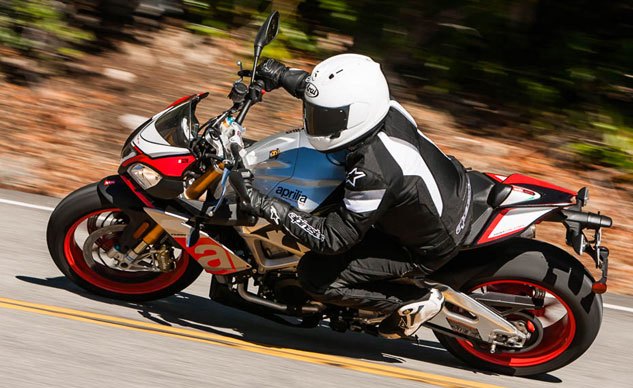


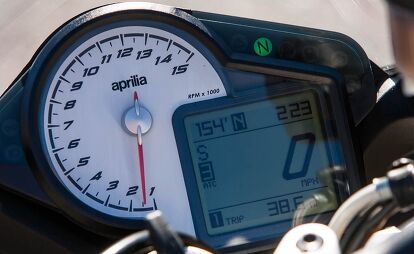















































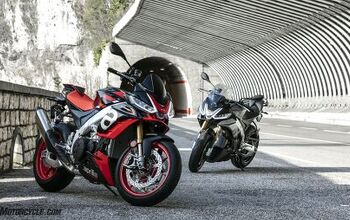
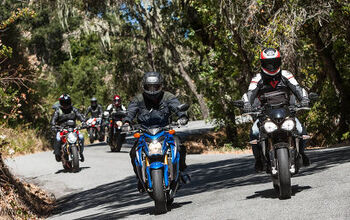

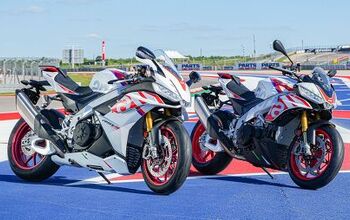
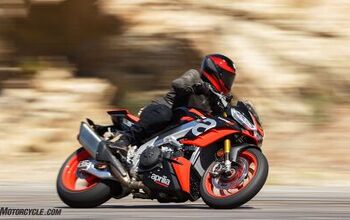











Comments
Join the conversation
Great work as usual Troy. I Can't argue with anyone who buys this bike. Pretty sweet!
Full of power and of course the wonderful personality of its V4, handles great, looks cool, is reasonably comfy and useful for real world street riding. This new Ape sounds fun! It is but an updated TFT gauge display and better fuel efficiency from sheer perfection.